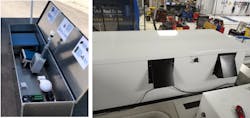UTA and air quality: The difference data can make
The Utah Transit Authority (UTA) has been helping collect air quality data since 2014. It has three TRAX trains outfitted with research grade monitors that cover the valley relaying emissions data every 10 seconds.
Air quality researchers from Salt Lake County and the University of Utah are taking this TRAX model a step further. They approached UTA in 2019 about monitoring air quality via bus routes, using electric buses to factor out the bus as a source of emissions. Discussions led to a groundbreaking research initiative. UTA says no other air quality monitoring program in the world exists at this density and scale.
Electric buses expand data collection
UTA identified routes, resources and vehicles to fit the research design. The three electric buses (e-buses) were outfitted in October 2021 with air quality sensors. The monitors on the e-buses offer additional data in three significant ways. One, unlike the TRAX monitors, these also capture Nitrogen Oxides (NOx) — which are primarily emitted from road vehicles. Two, they provide data in places rail cannot. Many bus routes run east to west in Salt Lake City offering direct comparison of air quality experiences in different areas. Three, buses can be dynamic. Unlike stationary rail, they can be deployed in specific areas to answer specific research questions.
This new data source allows researchers to examine trends at a neighborhood level, possibly revealing areas that experience significantly higher pollution than others. In other words, are certain groups of people disproportionately impacted by environmental pollution?
In short, the e-bus monitors provide real-time data that is combined with other data sources to draw clear connections between what is emitted into the air and the health, economic and social impacts of those emissions.
Dr. Daniel Mendoza and his research team
Daniel Mendoza, Ph.D., lead researcher with the air monitors, has resided in the Salt Lake Valley since 2014. Like many along the Wasatch Front, he copes with asthma and knows first hand how access to more granular information can help individuals make better health and lifestyle decisions. At the University of Utah, he holds faculty appointments in the Departments of Atmospheric Sciences, Internal Medicine and City & Metropolitan Planning, and at the NEXUS Institute in the College of Social and Behavioral Science. From this position he has published numerous papers, many that have already contributed to policy changes in Utah, like quantifying the impact of air pollution on school absences and standardized test results demonstrating the benefits of providing onsite emergency inhalers.
At a press event last July, Mendoza summarized it well when he said, “We have been successfully collecting data for over seven years for particulate matter and ozone data and with this we are adding nitrous oxide…we’ve been waiting for an electric bus platform so we can take a look at a neighborhood scale. When we look at neighborhood-specific data we can drill in and really see some social justice impacts.”
Partnership makes it possible
This research project has been made possible by a partnership between Salt Lake County (program lead), University of Utah, Utah Division of Air Quality and UTA. HEAL Utah led, and was awarded, an EPA Environmental Justice grant which will support the research team in acquiring an additional monitor. They work with researchers as a key community partner. The air monitoring program shows how UTA can work together to solve some of the most complex and urgent problems they face as a community. UTA says it is proud to serve the community by using its vehicles, maintenance, and logistics to support the gathering of robust air quality data.



